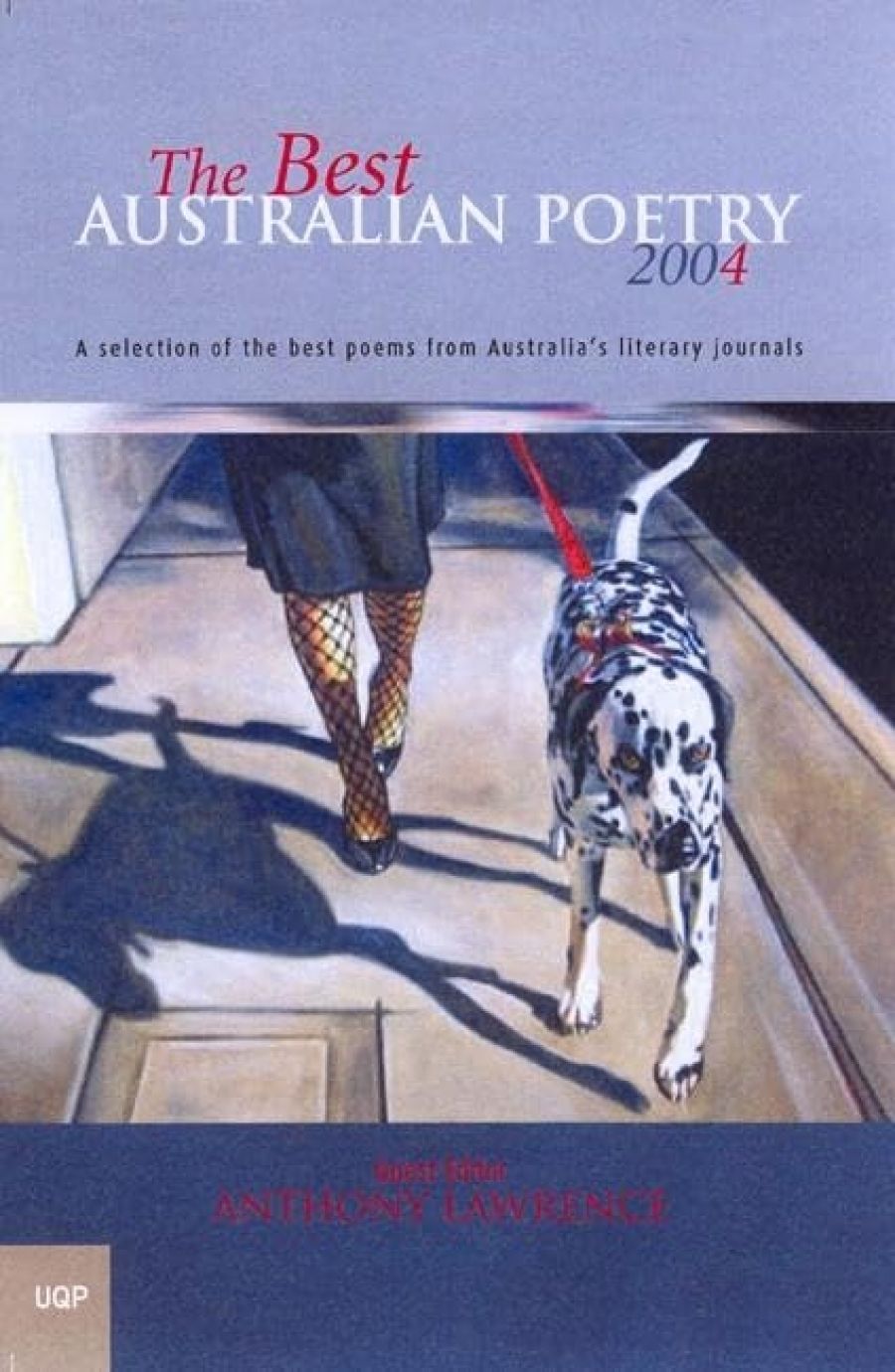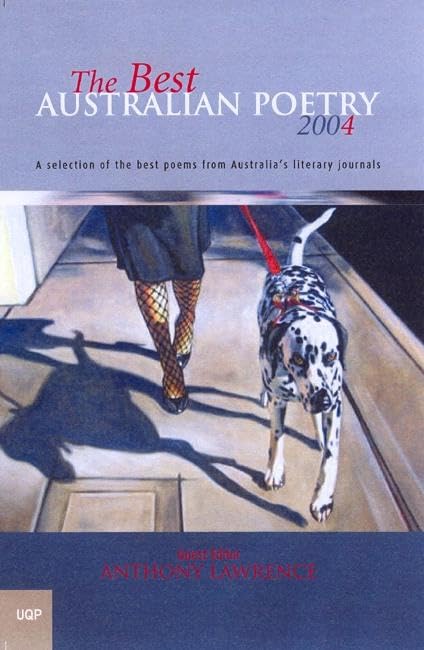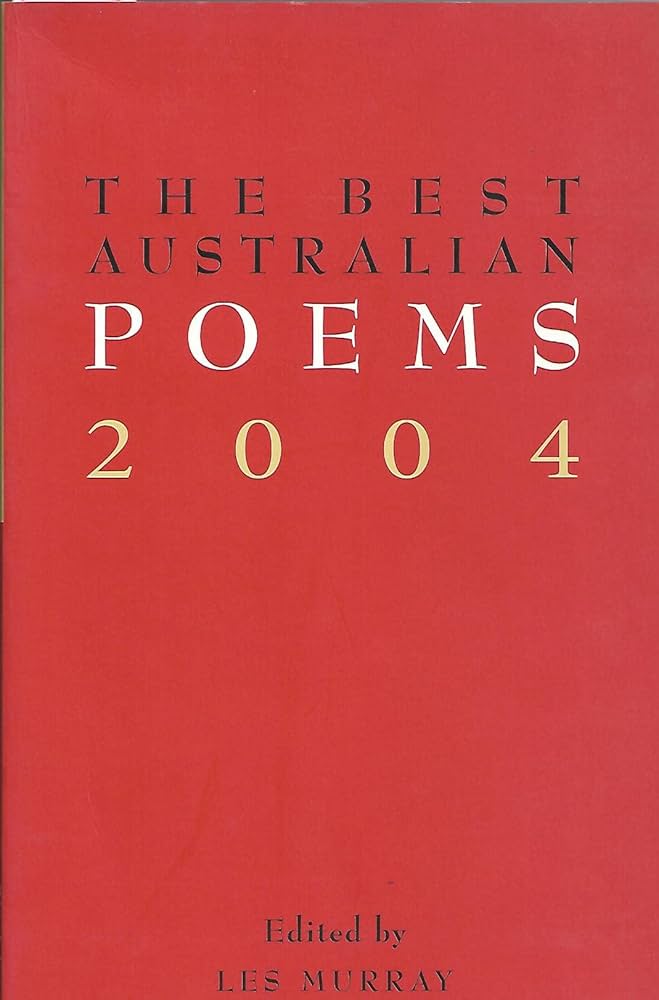
- Free Article: No
- Contents Category: Poetry
- Review Article: Yes
- Article Title: Risks and Lessons
- Online Only: No
- Custom Highlight Text:
Publishers and the publics they serve seem enthralled by the idea of ‘the best’. The best of what is ultimately less important than the superlative itself, which implies a rigorous screening process to isolate the most worthy material. Never mind that magazine and book publishers have already put writing through a brutal screening process with acceptance rates from .01 to 1 per cent. For readers whose schedules or temperaments prohibit them from doing the work themselves, a collection of ‘The Best’ can be useful and appealing.
- Book 1 Title: The Best Australian Poetry 2004
- Book 1 Biblio: UQP, $22.95pb, 156pp
- Book 1 Cover Small (400 x 600):

- Book 1 Cover (800 x 1200):

- Book 2 Title: The Best Australian Poems 2004
- Book 2 Biblio: Black Inc., $24.95pb, 221pp
- Book 2 Cover Small (400 x 600):

- Book 2 Cover (800 x 1200):

Perhaps unsurprisingly, it strikes this US-based reviewer as somewhat odd that Australia, which produces less than ten per cent of the number of poetry books as the US does (120 books each year versus 1400), needs two editions of ‘the best’ Australian poetry, where one version of The Best American Poetry seems to suffice. While one can hope the quality of the poetry makes two such volumes necessary, it’s likelier that something more pedestrian is happening: the publishers are trying to capitalise on readers’ ever-increasing desire to have their work done for them. This process requires readers to trust the editors of these volumes – more so than they do editors at magazines and presses, because the amount of material is so much smaller and the perception of ‘the best’ is being touted.
Readers’ initial responses to these volumes will depend partly on their opinions of the editors. Both 2004 editors – Anthony Lawrence and Les Murray – are highly regarded poets; between them, they have won just about every major poetry award offered in Australia. Lawrence’s wide knowledge of contemporary American, English and Irish poetry promises a catholic selection. But Murray has the bigger name, having been anointed the Australian poet in Australia and abroad, so readers are more likely to seek out and find his edition in stores. This is a shame because the Lawrence volume is the stronger of the two, despite being considerably shorter.
With its series editors, modest number of poets, one poem per poet format, and author notes, The Best Australian Poetry seems consciously modelled after The Best American Poetry. As inaugurated by Peter Craven, on the other hand, The Best Australian Poems 2003 resembled a traditional hierarchically oriented anthology. At thirty-eight poets, the 2003 volume introduced fewer poets than The Best Australian Poetry, but offered nearly 360 pages of poetry, which pretty much throttled the very notion of ‘the best’. The selection process did not represent poets equally, privileging Les Murray and Peter Porter from the older generation, and John Kinsella and M.T.C. Cronin from the younger/middle generation. Most disappointing was the lack of emphasis on discovery (of the thirty-eight poets, only one was unfamiliar to this reviewer). Craven’s selection process most likely was based on a combination of generosity (offering multiple poems by each poet) and avoidance (declining to winnow). But the generosity of Craven’s editorial approach was undercut by the limited number of poets, fewer than twenty-five per cent of whom are women. A truly representative volume would offer 360 pages of poems by 100 or more poets, not thirty-eight of the (mostly) usual suspects. Given the book’s emphasis, a more accurate title for Craven’s volume would have been The Best Australian Poets 2003.
Fortunately, Les Murray departs from the standard Craven sought to establish in 2003, offering one poem each by 127 poets in The Best Australian Poems 2004. Both 2004 volumes work to introduce poets who have yet to be anthologised or otherwise canonised, rather than be content to gather stars.
Despite being limited to forty poems, Lawrence’s selections in The Best Australian Poetry 2004 demonstrate more range, openness and intensity than Murray’s do. Of the forty poets in The Best Australian Poetry 2004, twenty are new to this reviewer, which seems to indicate that Lawrence has focused on individual poems, not on poets or their reputations. A number of these poets have yet to publish books or have just recently published their first books. The book also offers five memorable sequences, demonstrating ambition on both the poets’ and editor’s parts. Seven poems – Robert Adamson’s ‘Flag-Tailed Bird of Paradise’, Peter Boyle’s and M.T.C. Cronin’s collaborative sequence, ‘Objects of You in Water’, Luke Davies’s ‘Totem Poem’ (presented in excerpt), Dan Disney’s ‘Ecce Hombre’, Emma Lew’s ‘Sugared Path’, Kathryn Lomer’s ‘On the Tongue’ and Norman Talbot’s ‘Seven New South Wales Sonnet-Forms’ – are truly spectacular. The series format clearly has benefited Lawrence, in that the forty-poem limit forced him to make some difficult decisions. One gets no such feeling from Murray’s volume.
The 2004 editions share twelve poets in common: Judith Beveridge, Elizabeth Blackmore (whose ‘Dog Bite’, by the logic of these volumes, must qualify as the best Australian poem of 2004), M.T.C. Cronin, Luke Davies, Bruce Dawe, Kathryn Lomer, Graeme Miles, Thomas Shapcott, Vivian Smith, John Tranter, Chris Wallace-Crabbe and, most shockingly, Les Murray. One feels torn between rebuking Murray for including himself and praising him for managing to limit himself to only one of his own poems. In a general anthology of Australian poetry, Murray (or any Australian poet of stature) could be excused for including himself, but in an annual such as this the decision smacks of hubris. It would have been far more gracious, and generous, to save space for others and to sit it out for a year, as Lawrence did.
Among the magazines represented in The Best Australian Poetry 2004, Blue Dog: Australian Poetry, Meanjin and HEAT dominate, comprising nearly half the book. These same magazines represent less than five per cent of The Best Australian Poems 2004, which favours Quadrant, the magazine for which Murray serves as poetry editor. In fact, twenty-five of the 127 poems in The Best Australian Poems 2004 originally appeared in Quadrant. While twenty-five might not seem like a lot, it represents more than all other magazines combined. (Of the eighty poems in the two Best Australian Poetry volumes, only six are from Quadrant – and two of those are by Murray.) As a matter of editorial ethics, Murray should have omitted poems from Quadrant from the book. Besides, selecting poems he already has chosen seems too easy.
Further exacerbating this situation, the poems from Quadrant do not merit such skewed representation. They range from the entirely trite (Mary Bradley’s ‘Until Death Do Us Part’) to the quaint (Gregory Constantine’s ‘The Book’) to the awkward (Ross Gillett’s ‘Taking the Farm Car’) to the overlong (Hal Colebatch’s ‘Red-head with Phosphorus’) to the melodramatic (Meg Courtney’s ‘Sinking Ship’) to the sentimental (Suzanne Edgar’s ‘The Loneliness of Salt’). Rod Moran’s Quadrant poem, ‘My Daughter Reading’, is in some ways typical of the standard poem in this book: anecdotal, simultaneously casual and overwrought in its approach to language, and designed to instruct without offending or challenging the reader. The poem goes so far as to congratulate itself at the end for ‘a risk negotiated, a lesson learnt’. Ultimately, Murray’s is a book of tiny idea poems (see Murray’s own ‘The Cool Green’ for an example).
Although the Murray volume includes many lesser-known poets, the volume actually offers little in terms of worthwhile discovery because it includes more than its share of mediocre – trivial, slack. trite – poems. Many poems (such as Kevin Brophy’s ‘Life Size’ and Julian Croll’s ‘Green Thoughts in a Blue Shade’) are lineated by the phrase, with enjambments so soft and lines so flaccid that the lines and line breaks lack the linguistic tension one generally associates with poetry – a free verse without the returns of verse. A dozen poems end with a simile, the express route to epiphany. Some poems are so insignificant or so flawed in concept and execution that one feels embarrassed – for the poets, for Murray, for the very concept of ‘the best Australian poems’ – to read them. Take, for example, Matt Hetherington’s ‘Triads’, which reads like a lacklustre exercise gone sentimental: ‘3 possible things / humble leaders / the wisdom of spiders / dreams without fear.’ Whatever excitement one feels from encountering so many new poets, that excitement quickly gives way to weariness. Whereas Lawrence’s selections seem largely justifiable and hard-won, Murray’s choices recall the slush piles at many literary magazines, which consist mostly of competent yet unremarkable poems, poems written in leisure but with little urgency or vigour.
Murray’s selections disappoint partly because the book begins strongly, with Jordie Albiston’s ‘Collectables’, one of the most notable poems in the volume. The book includes half a dozen other excellent poems: Carolyn Fisher’s ‘Potato Country’, Barry Hill’s ‘A Long Swim’ (which includes the book’s most stunning line), Mike Ladd’s ‘A Vegetative Life’, Philip Salom’s ‘The Family Fig Trees’ (which is highly descriptive, deftly metaphoric, meditative, sometimes precious, and technically adroit), Craig Sherborne’s ‘Suburban Confidential’ and John Tranter’s ‘Journey’ – but those poems are buried rather than illuminated by Murray. Lawrence manages as many gems as Murray, and in a book with one-third the number of poems.


Comments powered by CComment